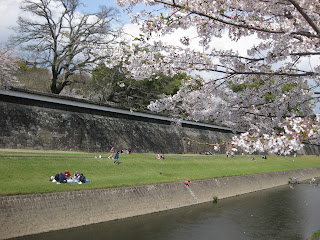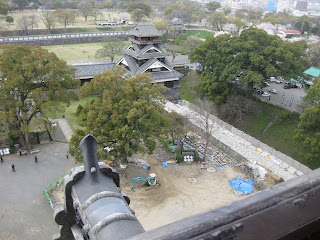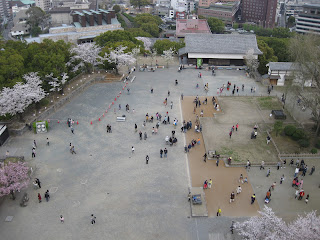And some just come to view the beauty.
Oh the Cherry blossoms are beautiful also.
We started at the Sudoguchi Gate, As best as I can tell this means bamboo gate which is foolish to enter. Given the trecherous path and many steep rock lined walls to the main tower, I can understand why it would be a foolish door to enter for an invading force.
We visited the Main Tower and the Honmaru-goten Palace today as there it is much to large to see in a single P-day.
We finally made it to the base of the main castle tower.
Admission to the main tower, 7 stories tall, was free, but you had to get past the Imperial guard.
Most of the antiquities inside were posted as do not photograph. Here is an example of typical Japanese roof line decorations.
We finally made it to the top and were treated to fantastic views of the grounds and surounding areas.
This is the area where the photo above was taken at the base of the main tower, which is itself is on top of a large hill with many very steep, rock lined walls that would prove the undoing of the disenchanted Samurai warriors of the 1877 Satsuma Rebellion.
After coming down we encountered this ferocious looking warrier.
Here is what I posted on facebook about this facinating castle.
The Satsuma Rebellion: Its 1877 and we now have Kumamoto castle in the hands of the newly established Meiji Imperial Empire. This was an uprising and revolt against the Government by disenchanted samurai warriors who were upset over changes, and their loss of power because of them. Saigo arrived with his 20,000 samurai and attacked Kumamoto Castle. Saigo’s army was not only well trained samurai warriors with superior sword skills, they are also armed with the latest guns, rifles, and artillery that the imperial army had been using to their advantage. The few thousand defending troops learned very quickly that the 250-year-old wooden structures of the castle were no match for modern artillery. The main tower of the Castle (called the tenshu in Japanese) was blasted by artillery and burned to the ground. To make matters worse, another one of the buildings that caught fire was holding their food supply. Even with all these factors in Saigo’s favor, He could not penetrate the defensive structures of Kumamoto Castle. It is a tribute to it's design and engineering that the samurai army could not get through the maze of gates or over the curved stone walls.
The Castle and defending troops held out for 7 weeks cut off from support and under constant attack. When the main Imperial army of near 100,000 troops arrived by land and sea, the tired and depleted samurai army was chased out of Kumamoto. It is such a dramatic and epic story that they should make a movie about it. Oh wait.. They did make a movie abut it. Its called The Last Samurai. By the way, this movie was not actually filmed in Kumamoto or in Japan, thats "Hollywood" for you.
The Castle and defending troops held out for 7 weeks cut off from support and under constant attack. When the main Imperial army of near 100,000 troops arrived by land and sea, the tired and depleted samurai army was chased out of Kumamoto. It is such a dramatic and epic story that they should make a movie about it. Oh wait.. They did make a movie abut it. Its called The Last Samurai. By the way, this movie was not actually filmed in Kumamoto or in Japan, thats "Hollywood" for you.
We next went to the Honmaru-goten Palace. It is a huge building that takes over 1500 tatami mats to cover the floor. We had to remove our shoes when entering. Here are some photos.
What a fantastic day and there is much more to see on other P-days.
In the early part of Tuesday Luetta and I had speparate Skype classes from our Language Specialist at the Provo, MTC. He is working with us on learning our learning styles and developing goals in our language learning. Here is a screen capture of the S.M.A.R.T. goal setting criterion.
We are selectin goals for our Japanese development. I have selected words I own (vocabulary), verbs/conjugation that I own, Sentense types I own, Native Japanese Language interations per day, and several other mission related goals. This is a fun class and I so much appreciate the special post MTC language Skype classes the church allows us to have. We also have a Language Tutor who specifically helps us with language learning, and another specialist that has not been assigned yet. Wow!
Tuesday was also District meeting. The sisters asked for a ride to there which we were happy to help with, but they surprised us with a spiritual thought while we drove about everything getting better and better. They couldn't have realized that our spirits were at a low point and there message was so much appreciated and we saw it as God's love being sent to us through His missionaries, while we are deaf and dumb in Japan. We have so much appreciation for those in a foreign country with little language. We are lucky that so many try to speak and do speak to us in English, and the language of Angels (the Holy Spirit). While at District meeting we were instructed by the zone leaders on companion relationships. They used two photos taken at Kumamoto Castle the day before, one that one elder took of the beautify scene of Cherry Blossoms and one that another elder took of the precipice he was leaning out off and being supported by his companion. One of the Elders that is a good artist then created a drawing using the descriptions of the two groups that described one of the pictures. It turned out rather well.
Wednesday we spend most of the day picking up Eikwai (English Class) posters and getting ready for the next drawing for three weeks of having our posters up around all of Kumamoto. As far as we know, no one has come as result of them yet. It it doesn't prove fruitfull in about 3-4 cycles we will find other methods. The flyers at the internation center had two people that have come so far and a member that works there has set us up for two more months of posting. In the second story area where we take Japanese classe from a Native Japanese ex High School teacher we put up 6 larger flyers and three had been taken when we looked last. We hope to get new students with these. Learning English is very popular in Japan.
Thursday, we finished picking up posters in the downtown part of town and in areas we had not driven before. It was a real adventure as none of these community boards were programmed into the Gramin yet, so it was map (in 100% Japanese) and our wits.
We took this photo of our apartment building. Ours is the top floor, fartherest left.
Friday was a great day, we took the zone leaders to visit a smaller island south of Kumamoto. Here is a map of the area, in fact we crossed via bridges many islands to get there.
Here is a bit of history of this area. "Amakusa is a group of islands to the southwest of Kumamoto Prefecture. Relatively-large three islands and the mainland surround Yatsushiro Sea, and many other small islands are around there.
Also Uto Peninsula in Kumamoto Prefecture and Shimabara Peninsula in Nagasaki Prefecture are close to this islands. The large three islands are Kamishima, Shimoshima and Nagashima.
Between Kamishima and Shimoshima, there is a narrow channel like a canal. Christianity was first introduced to Japan in 1549 by Saint Francis Xavier, a Catholic missionary belonging to the Society of Jesus. Then eager missionary works were done based in Hirado or Nagasaki in Nagasaki Prefecture. Christianity was also introduced in Shimoshima in 1566, and it got many believers.
In the late 16th century, many churches and a seminary were built in this islands.
But Christianity was banned in 1587, and the lords around this area suppressed the Christians.
In the result, the people in Amakusa and Shimabara revolted against the tyranny of the lords in 1637 in conspiracy. But many of them were killed out at an old castle in Shimabara where they took refuge. Since that, remaining Christians had hidden in this islands until the lifting of the ban of Christianity in 1873. Even now, about 30 percent of Amakusa people are Christians."
Here are a few photos from the car of our travel there on a cloudy, but not rainey day. I loved the palm trees, and ocean views, reminded me of California, but more green.
Here is a fameous christian church. We didn't have time to tour, but took pictures from the car window.
Mormonism is, obviously, a relatively recent addition to the diversity of the area, but it is struggling. There use to be a ward in Amakusa, but it is not anymore. We were determined to visit some of the about 40 less active members on the island. One active member met us at a common resturant in Japan, Joyfull.
We were able to visit three less active families, teach three lessons that included two non-members, give out two Book of Mormons and invite one to to follow the example of Jesus Christ and be baptised by restored authority. We invited them all to attend an upcoming Ward Conference in Kumamoto as well. We expect to return many times to this fantastic island and hope that with the nearly doubling of the number of missionaries in this mission to have them return to a full time presence in Amakusa.
After a fantastic day, we left as the evening approached.
We tried to visit one last person, and we went up this lovely valley/canyon with water filled rice fields.
But, we coulda not find the family, even though we were told that last name was wide spread in the area.
Saturday we had our second Japense tutor from the MTC. Did you know that in Japanese you can conjugate adjectives to present + and -, as well as past + or -. Who would have quessed. We also had English class at 2 p.m. We were very surprised when two of our students gave us a wonderful gift of Kumamoto Mandarin Oranges, big ones.
Then in the evening a wonderful Kumamoto Ward activity celelebration the grown of the church since Cumorah and in Japan. This event is befor Ward Conference on Sunday. Here are the five stations:
First a 30 minute First Vision movie in Japanese.
Joseph Smith in Palmyra.
Early Missionary work.
Building the Church.
Many look at of photos of missionaries that have served both here and from here,
and here is one more.














































What I like about Japan is that they have preserved the ancient buildings. In China they have mostly been torn down and rebuilt. Kind of a let down. Daniel will appreciate your lack of language. He knows a few words, but by and large is "mute". But it hasn't stopped him from buying treats or negotiating for things he wants in the market. :)
ReplyDelete